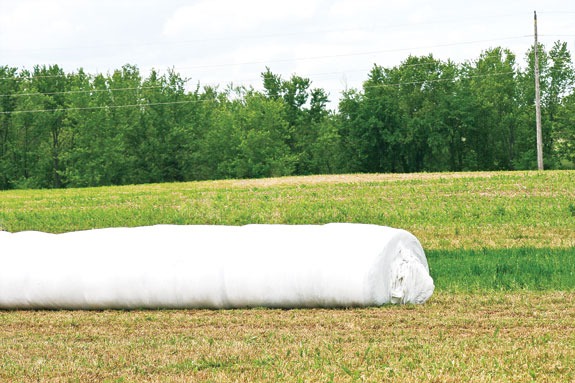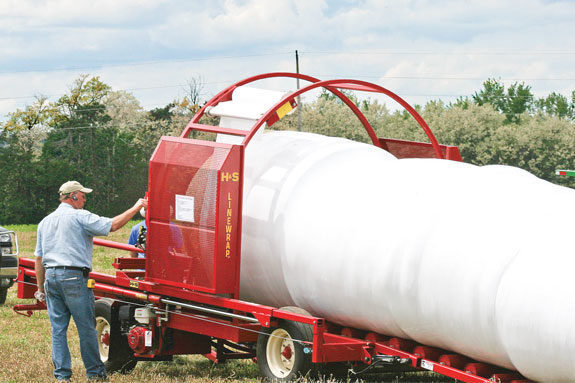Forage may be stored for winter feeding when pasture production is limited, for use in confinement feeding systems or for cash hay. Hay is the most popular storage method since it stores well for long periods and is better suited to cash sale and transportation than silage. However, silage may be more suitable in some situations where hay curing is difficult.
It is possible to make high-quality silage or haylage using long (unchopped) forage crops baled with large round balers, although balers may need modification to handle wet material.
Round bale silage (or balage) is the product of cutting forage crops with conventional hay harvest equipment, allowing the forage to wilt to between 40 and 60 percent dry matter, baling the forage into tight bales and quickly wrapping the bales in plastic so oxygen is excluded.
The forage in the bale then goes through the ensiling process. The wrap keeps out air, allowing anaerobic microorganisms to ferment carbohydrates to lactic acid which inhibits the growth of other detrimental microorganisms.
The ensiling process uses some dry matter or energy, but this loss is small compared to dry matter losses that result from raking, baling, tedding and, particularly, storing round bales outside as hay.
Advantage and disadvantages of baling
Advantages of making round bale silage include:
• Plastic cost per bale is low.
• Capital investment required is lower than conventional silage storage.
• Higher-quality feed is produced.
• Harvest and storage losses are lower.
• Weather damage is less than hay stored outside.
• Individually wrapped silage bales are more portable.
• Small amounts of forage can be ensiled.
• Baled silage feeding does not require specialized machinery.
Disadvantages of baled silage include:
• Long (unchopped) forage crops are harder to ensile (less fermentable carbohydrates) than chopped forage.
• Some balers cannot handle wilted (40 to 50 percent dry matter) forage.
• Bales can be very heavy, leading to larger tractor requirements.
• Plastic wrap material can tear or puncture, leading to spoilage.
• Disposal of used plastic is necessary.
Forage requirements
Most of the major forages can be harvested effectively as balage. To do this, cut at the proper stage of maturity so that the forage contains adequate levels of fermentable carbohydrates for good ensiling.
In general, harvesting forage crops in the transition stage between vegetative (leafy, immature) and reproductive, or flowering stage, will produce the best compromise between yield and quality.
Harvest losses (usually from leaf shatter and loss) are greatest for very dry forage but are low for herbage handled immediately after cutting. However, silage baled too wet is subject to excessive storage losses due to seepage and deterioration.
Storage losses arise from microbial activity in moist forage and therefore are generally minimized by harvesting at low moisture levels. Minimum combined field and storage losses are achieved by harvesting forage in the middle of the moisture range, between 40 and 70 percent moisture.
The reasons for field losses in forage harvesting are respiration, leaching and some leaf loss.
The dry matter levels recommended for baled silage are generally between 40 and 60 percent, covering the range between wilted silage and haylage.
The ideal dry matter content appears to be 40 to 50 percent because fermentation is adequate and heat damage is minimized. In producing bales for bagged or wrapped silage, it is important to remember that forage in the 50 percent dry matter range will weigh about twice what the same size bale of hay would weigh.
Bale size is frequently reduced to restrict bale weight to 0.75 to 1.0 ton. Heavier packages may be difficult to transport.
Machinery requirements
Equipment needs are quite simple. The mower does not need to have conditioning rollers, but mower-conditioners are useful because they concentrate the cut forage into a narrow swath. These narrow swaths allow baling without raking.
If the mower leaves a wide swath, it should be raked to ensure adequate pickup into the baler.
Since the forage is wet and heavy, bale diameters generally range from 42 to 48 inches to avoid overloading either the baler or the transport equipment.
Bales should be formed as tightly as practical. Some people believe belt-type balers make a more uniform bale than chain-type balers, but no research supports this claim.
Fixed-chamber hay balers lack the flexibility of variable-chamber balers to vary bale diameter as a means of reducing bale weight in wetter crops. Fixed-chamber silage bales have smaller diameters.
The ground speed of the baler should be lower than speeds used in making field-cured hay. Downshifting one gear should help to guarantee a tighter, denser bale. A dry matter density of 10 pounds per cubic foot is considered ideal.
A typical silage bale (4 feet in diameter by 5 feet in length) should weigh 1,300 to 1,550 pounds and contain 600 to 650 pounds of dry matter, but it may weigh as much as a ton.
Some baler manufacturers recommend retrofitting older balers with kits that aid in baling wet forage. Many manufacturers produce balers designed specifically for making balage.
Some recent models of both fixed and variable chamber balers include knife mechanisms to chop the forage, allowing increased density. University of Kentucky research found that using a “chopping” fixed-chamber baler increased silage bale weights by about 300 pounds at the same bale diameter.
Traditional bale spears can be used to move round bales of silage, but have the disadvantage of puncturing the plastic if the bale is moved after wrapping.
Wrapping the bales after they have been moved to their place of storage will avoid puncturing the plastic. Another more expensive option is the hydraulic bale squeeze that mounts on a front-end loader.
This implement allows the movement of wrapped bales without making holes in the plastic. Tractors with 50 or more horsepower have sufficient weight and power for safe lifting.
Bale-wrapping and bagging equipment
There are many ways to seal freshly baled forage, including individual bags, tubing machines, and individual or group bale-wrapping machines. All operate on the principle of quickly sealing out oxygen from the bale and keeping it airtight until the balage is fed.
Use of plastic manufactured to withstand the damage from ultraviolet radiation in sunlight is strongly recommended. Some plastic manufacturers recommend using untreated sisal twine or plastic twine. In some cases, the oil from treated sisal twine breaks down the ultraviolet radiation inhibitor in stretch-wrap plastic.
Individual bags
Using individual bags has two advantages: extra equipment is not required, and the bags can be reused to reduce the cost. In practice, however, few bags can be salvaged for use in the next growing season.
Disadvantages include the difficulty of getting all of the air out of the bags and maintaining a good seal on the open end of the bag. Making balage in individual bags is less reliable than with wrapping equipment.
Rodent damage also appears to be more prevalent with individual bags compared to wrapped bales.
Long tubes
Round bales can be loaded mechanically into long plastic tubes that are mechanically stretched during loading and then allowed to contract. This process aids in getting a good seal around the bale.
The number of bales per tube is flexible (plastic can be cut and sealed). Disadvantages include the need for a uniform ground base for tube placement (if large) and sizing bales to the tube.
Also, a hole in a long tube exposes a large amount of silage to potential spoilage. Finally, large bales stored in tubes are less portable than individually wrapped bales.
Individually wrapped bales
The most popular form of baled silage is individual bales wrapped mechanically with four layers of stretch-wrap plastic. Each layer of stretch-wrap plastic adheres to the previous one, forming an airtight seal.
Wrapping machines vary widely in cost ($4,000 to $15,000), depending on such features as whether they produce a completely wrapped bale and whether they include a self-loading arm.
The cheapest wrappers require a second person (or getting off the tractor) and manually moving the roll of stretch plastic while the bale is rotated on a spear, much like twine is applied to round bales of hay.
The plastic is lapped over the ends of the bale about 12 inches. Single or multiple bales can be sealed by manually stretching plastic across the exposed ends. Jamming multiple bales together (flat end to flat end) allows the plastic from one bale to stick to the next, forming a tube.
A uniform, level soil surface is necessary for good bale-to-bale contact and the maintenance of a good seal.
More expensive wrappers completely cover each bale by elevating the bale onto a rotating and revolving platform. Some have hydraulic lifts to elevate the bales onto the platform. Others require a second tractor with lifting capabilities to put the bale on the wrapper.
Other considerations
Damage to plastic during handling or storage allows oxygen to enter the bale, causing spoilage. Any holes made during bale transport and placement into storage should be repaired immediately by taping.
Holes allow oxygen to enter and lead to problems with silage quality due to aerobic deterioration. To minimize storage losses due to spoilage, bagged silage bales should be fed to livestock during the winter following their production.
Do not feed silage that has significantly deteriorated or has a bad odor. Silage that improperly ferments from being too wet can lead to botulism poisoning.
To prevent this, do not make silage at moisture contents above 70 percent. Exposure to oxygen can also lead to deteriorated silage and animal toxicity. Unrepaired holes or having too few layers of stretchwrap plastic can lead to oxygen infiltration of the bale.
Time between baling and bagging or wrapping
The interval between baling and wrapping or bagging is critical to the success of the ensiling process and should be as short as possible. Prior to wrapping, high-moisture forage is subject to very high respiration rates and to the growth of undesirable microorganisms.
Respiration reduces forage quality by consuming readily digestible carbohydrates. Significant increases in bale temperature are also associated with excessive delay between baling and bagging of silage bales.
Consider moving freshly baled forage to the storage area for wrapping. This allows the wrapping process to be done on more level, uniform ground. Bales can “walk off” the wrapping platform if the machine is not level.
Minimizing movement of wrapped bales will reduce tearing of the plastic. Wrapped bales can be speared for movement if these holes are resealed.
Consider identifying different types of balage and different cuttings by marking with spray paint. Different colors could represent the various crops while the number of marks (dots or Xs, for example) could indicate the cutting (one dot for first cutting, two dots for second cutting, etc.).
Benefits
Storing wet forage as balage will allow more timely cutting and harvesting of high-quality forage crops.
University of Kentucky research compared baled alfalfa silage at three moisture levels with field-cured hay (stored outside on the ground). Baled silage retained initial protein and in vitro digestibility levels of the fresh forage better than the field-cured hay.
Field-cured hay declined significantly in digestibility and had large dry matter losses compared to baled silage. FG
References omitted due to space,but are available upon request.
—Excerpts from University of Kentucky College of Agriculture Extension website
PHOTOSPHOTO 1: Dry matter levels recommended for baled silage are generally between 40 and 60 percent.
PHOTO 2: The interval between baling and wrapping or bagging is critical to the success of the ensiling process and should be as short as possible. Photos by FG staff.












